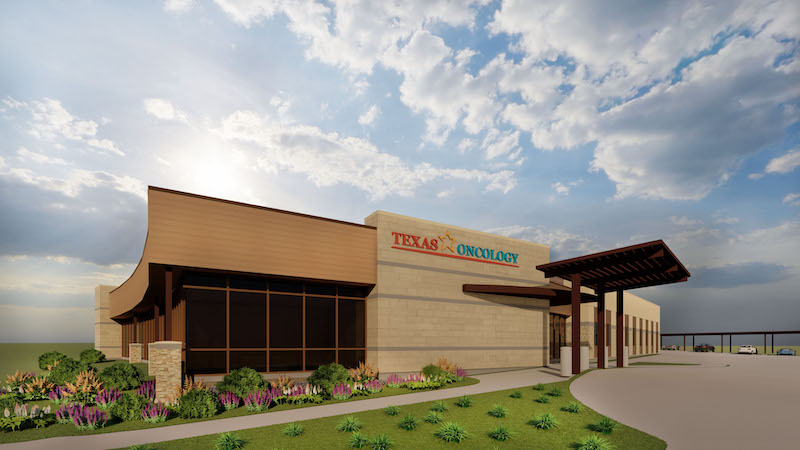While Texas’s cancer rate per 100,000 residents is among the lowest in the nation, more than 133,730 Texans will be diagnosed with cancer in 2021, including nearly 21,000 new breast cancer patients, according to The American Cancer Society’s estimates.
To expand access to comprehensive cancer care, Texas Oncology—with 500-plus physicians and 210 locations across the state—recently broke ground on a 22,300-sf cancer care center in Fort Worth’s Alliance Town Center. When it opens next year, the cancer center will provide medical oncology, hematology, radiation oncology and infusion treatments.
“The development of this new cancer care facility confirms our commitment to providing innovative comprehensive, and individualized care for patients across Texas,” says R. Steven Paulson, M.D., president and chairman of Texas Oncology.
AGGRESSIVE GROWTH

The recently opened cancer care center in Denison, Texas, consolidates two older facilities.
The building will replace an existing Texas Oncology site in Keller, Texas. The building team executing this project includes the developers Hillwood and Meridien, architects Corgan and E4H, and the general contractor DPR Construction.
Last month, Texas Oncology consolidated its locations in Sherman and Denison, Texas, into a new 26,000-sf cancer care center in Denison, with an integrated team of six physicians and more than 85 support staff. And in April, Texas Oncology and Christus Health broke ground on an 85,000-sf Northeast Texas Cancer and Research Institute in Tyler, Texas, with an anticipated 2022 opening. The Tyler facility will include 30,000 sf of clinic space and nearly 3,000 sf for research. Christus Health will house a 7,500-sf advanced imaging center. Another 10,000 sf will support the surgical oncology programs of the Louise Herrington Cancer Center.
Related Stories
Great Solutions | Aug 23, 2016
GBBN designers take on wellness research
In a new research paper, three healthcare specialists present factors that contribute to a psychological state that is receptive to healing.
Great Solutions | Aug 23, 2016
Reusable infection control barriers ease hospital renovation
Clark Construction Group pilots the Edge Guard system on the Fair Oaks (Va.) Hospital reconstruction project.
Great Solutions | Aug 23, 2016
Mobile emergency room arrives just in time for Alabama hospital
The MED-1 Mobile Hospital Unit serves as a lower-cost solution during construction of new ED.
Great Solutions | Aug 23, 2016
Virtual care facility serves remote patients, may reduce readmissions
Mercy’s new high-tech medical center equips its medical professionals to deliver care at the bedside of patients anywhere.
Great Solutions | Aug 23, 2016
11 great solutions for the commercial construction market
A roll-up emergency department, next-gen telemedicine center, and biophilic cooling pods are among the AEC industry’s clever ideas and novel innovations for 2016.
Healthcare Facilities | Aug 16, 2016
The future of healthcare design education: 5 takeaways from ACHA 2016
Creating a network of experts to talk next generation healthcare design education
Healthcare Facilities | Aug 15, 2016
Future proofing hospitals
By improving the physical layout of hospitals and medical facilities, we can enhance and increase safety mechanisms, improve care, and help reduce the exposure to medical errors, writes Skanska USA's Andrew Quirk.
Healthcare Facilities | Aug 10, 2016
11 principles for pediatric healthcare design
Engagement at all levels, designing with families in mind, and integrating flexible spaces are all important design considerations to keep in mind for pediatric healthcare planning, writes HDR's Brian Zabloudil.
Healthcare Facilities | Aug 9, 2016
Key strategies to reduce healthcare facility costs and maintain operations
The right approach during the planning, design, and construction of a new facility can yield a positive return on investment and lower the overall cost basis for ongoing operations, writes Steve Higgs, Senior Managing Director with CBRE Healthcare.
| Aug 8, 2016
HEALTHCARE GIANTS: Age-simulation technology aids design for the mobility impaired
As the 65+ population continues to rise, the AEC industry needs to better understand the stresses and anxieties those who are mobility impaired face when navigating spaces like medical facilities.

















